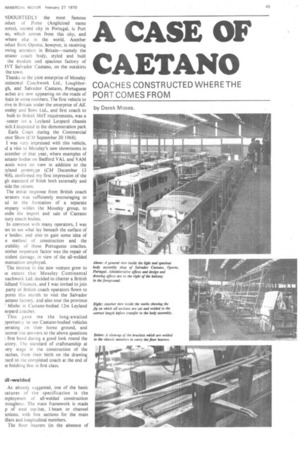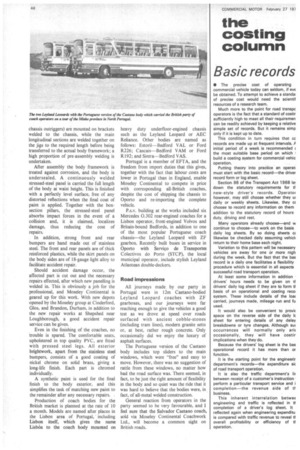A CASE OF CAETANO
Page 47

Page 48

If you've noticed an error in this article please click here to report it so we can fix it.
COACHES CONSTRUCTED WHERE THE PORT COMES FROM
by Derek Moses. !sIDOUBTEDLY the most famous oduct of Porto (Anglicized name ]ono), second city in Portugal, is Port ne, which comes from this city, and owhere else in the world. Another oduct from Oporto, however, is receiving awing attention in Britain—namely the teta.no coach body, styled and built the modern and spacious factory of 1VT Salvador Caetano, on the outskirts the town.
Thanks to the joint enterprise of Moseley mtinental Coachwork Ltd., Loughborgh, and Salvador Caetano, Portuguese aches are now appearing on the roads of itain in some numbers. The first vehicle to rive in Britain under the enterprise of Alf.
oseley and Sons Ltd., and first coach to built to British MoT requirements, was a -seater on a Leyland Leopard chassis iich I inspected in the demonstration park Earls Court during the Commercial otor Show (CM September 20 1968).
I was very impressed with this vehicle, id a visit to Moseley's new showrooms in member of that year, where examples of aetano bodies on Bedford VAL and VAM Lassis were on view in addition to the yland prototype (CM December 13 P68), confirmed my first impression of the gh standard of finish both externally and side the saloon.
The initial response from British coach )erators was sufficiently encouraging to ad to the formation of a separate impany within the Moseley group, to indle the import and sale of Caetano xury coach bodies.
In common with many operators, I was en to see what lay beneath the surface of e bodies, and also to gain some idea of e method of construction and the trability of these Portuguese coaches.
nother important factor was the repair of ;eident damage, in view of the all-welded Instruction employed.
The interest in the new venture grew to Le extent that Moseley Continental oachwork Ltd. decided to charter a British lidland Viscount, and I was invited to join party of British coach operators flown to port° this month to visit the Salvador aetano factory, and also tour the province ' Minho in Caetano-bodied 12m Leyland eopard coaches.
This gave me the long-awaited pportunity to see Caetano-bodied vehicles perating on their home ground, and ,scover the answers to the above questions : first hand during a good look round the
ictory. "the standard of craftmanship at iery stage in the construction of the mches, from their birth on the drawing Dard to the completed coach at the end of te finishing line, is first class:
01-welded
As already suggested, one of the basic aatures of the specification is the mploytnent of all-welded construction iroughout. The main framework is made p of steel top-hat, 1-beam or channel actions, with box sections for the main illars and longitudinal members.
The floor bearers (in the absence of chassis outriggers) are mounted on brackets welded to the chassis, while the main longitudinal sections are welded together on the jigs to the required length before being transferred to the actual body framework; a high proportion of pre-assembly welding is undertaken.
After assembly the body framework is treated against corrosion, and the body is undersealed. A continuously welded stressed-steel panel is carried the full length of the body at waist height. This is finished with a perfectly level surface, free of any distorted reflections when the final coat of paint is applied. Together with the boxsection pillars, the stressed-steel panel absorbs impact forces in the event of a collision and, it is claimed, localizes damage, thus reducing the cost of repairs.
In addition, strong front and rear bumpers are hand made out of stainless steel. The front and rear panels are of thick reinforced plastics, while the skirt panels on the body sides are of I 8-gauge light alloy to facilitate accident repair.
Should accident damage occur, the affected part is cut out and the necessary repairs effected, after which new panelling is welded in. This is obviously a job for the professional, and Moseley Continental is geared up for this work. With new depots opened by the Moseley group at Cinderford, Glos, and Brandon, Durham, in addition to the new repair works at Shepshed near Loughborough, a good accident repair service can be given.
Even in the finishing of the coaches, no trouble is spared. The comfortable seats, upholstered in top quality PVC, are fitted with pressed steel legs. All exterior brightwork, apart from the stainless steel bumpers, consists of a good coating of nickel chrome on solid brass, giving a long-fife finish. Each part is chromed individually.
A synthetic paint is used for the final finish to the body exterior, and this simplifies the task of matching new paint to the remainder after any necessary repairs.
Production of coach bodies for the British market is planned at the rate of 10 a month. Models are named after places in the Lisbon area of Portugal, including Lisbon itself, which gives the name Lisboa to the coach body mounted on heavy duty underfloor-engined chassis such as the Leyland Leopard or AEC Reliance. Other bodies are named as follows: Estoril Bedford VAL or Ford R226; Cascais—Bedford VAM or Ford R192; and Sintra—Bedford VAS.
Portugal is a member of EFTA, and the freedom from import duties that this gives, together with the fact that labour costs are lower in Portugal than in England, enable Moseley Continental to compete in price with corresponding all-British coaches, despite the cost of shipping the chassis to Oporto and re-importing the complete vehicle.
P.s.v. building at the works included six Mercedes 0.302 rear-engined coaches for a Lisbon operator, front-engined Volvos and Britain-bound Bedfords, in addition to one of the most popular Portuguese coach chassis—the Leyland Leopard with ZF gearbox. Recently built buses in service in Oporto with Servico de Transportes Colectivos do Porto (STCP), the local municipal operator, include stylish Leyland Atlantean double-deckers.
Road impressions All journeys made, by our party in Portugal were in 12m Caetano-bodied Leyland Leopard coaches with ZE gearboxes, and our journeys were far reaching enough to give the vehicles a good test as we drove at speed over roads surfaced with ancient cobble-stones (including tram lines), modern granite setts or, at best, rather rough concrete. Only occasionally did we enjoy the luxury of asphalt surfaces.
The Portuguese version of the Caetano body includes top sliders to the main windows, which were "free" and easy to move. However, there was no suggestion of rattle from these windows, no matter how bad the road surface was. There seemed, in fact, to be just the right amount of flexibility in the body and so quiet was the ride that it was hard to believe that the bodies were, in• fact, of all-metal welded construction.
General reaction from operators in the party seemed to be very favourable, and I feel sure that the Salvador Caetano coach, sold via Moseley Continental Coachwork Ltd., will become a common sight on British roads.




































































































